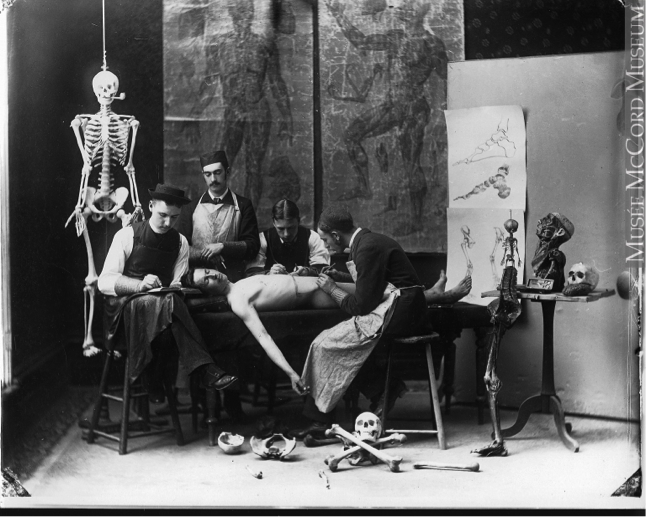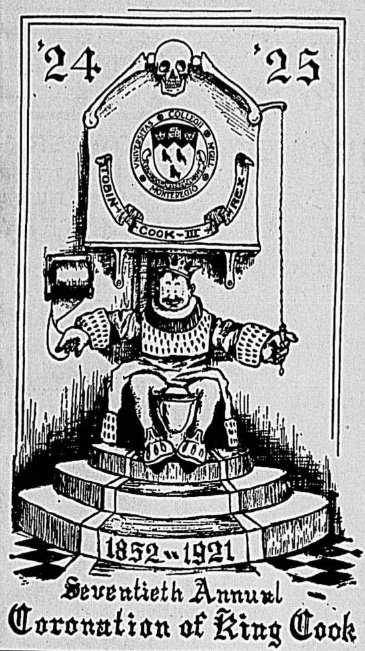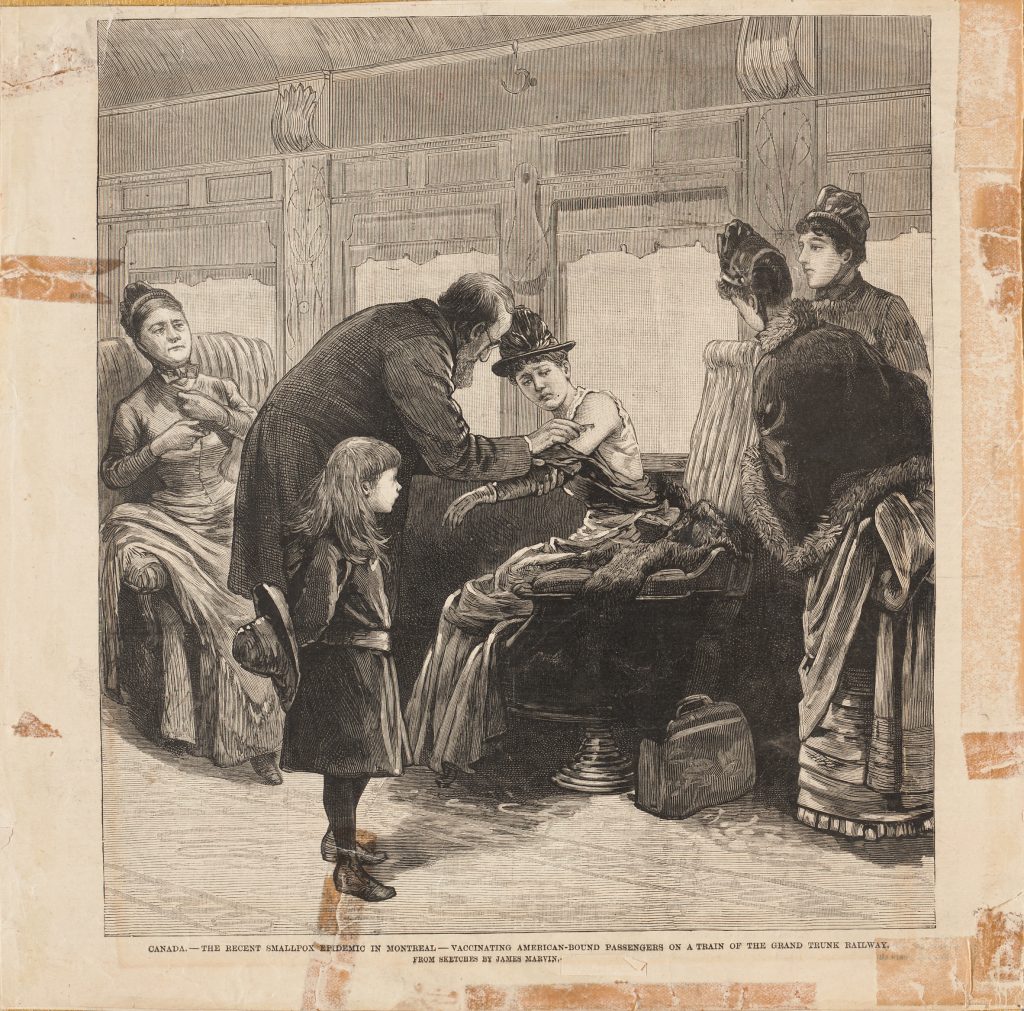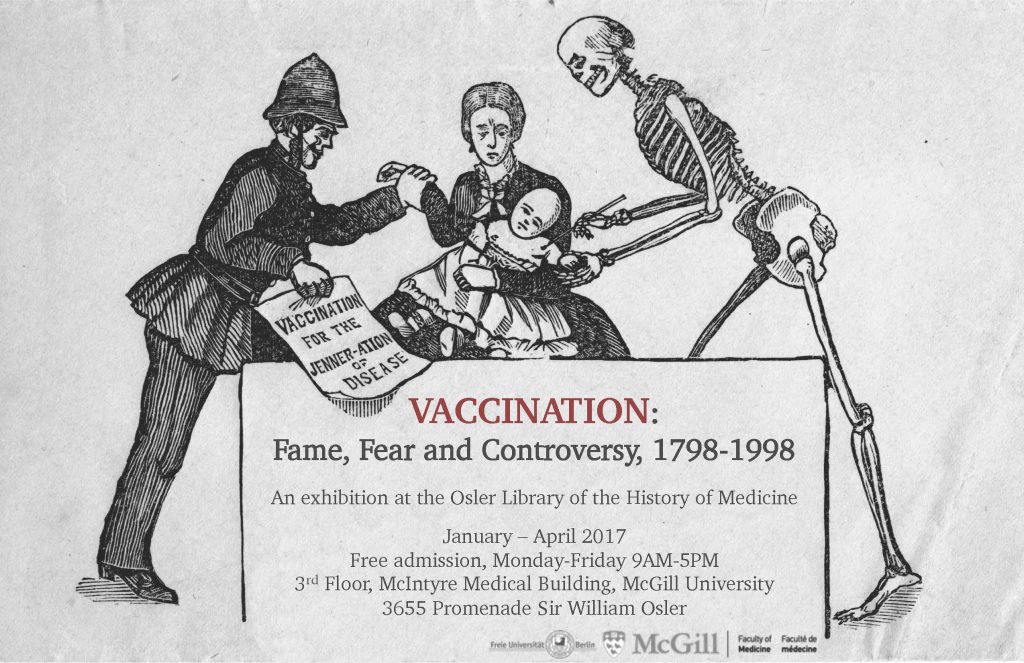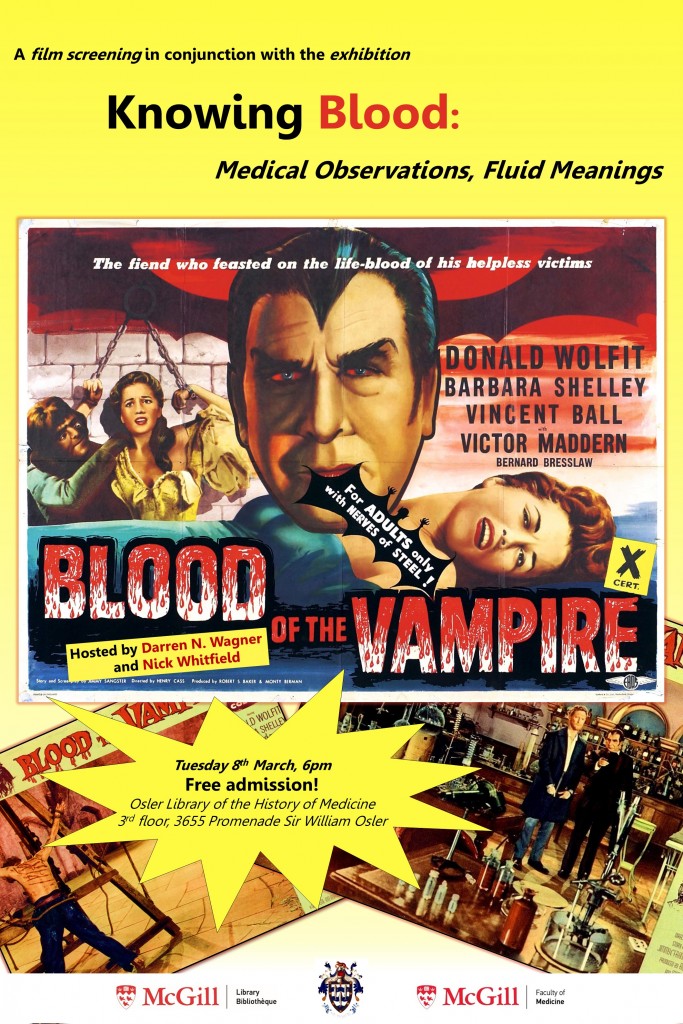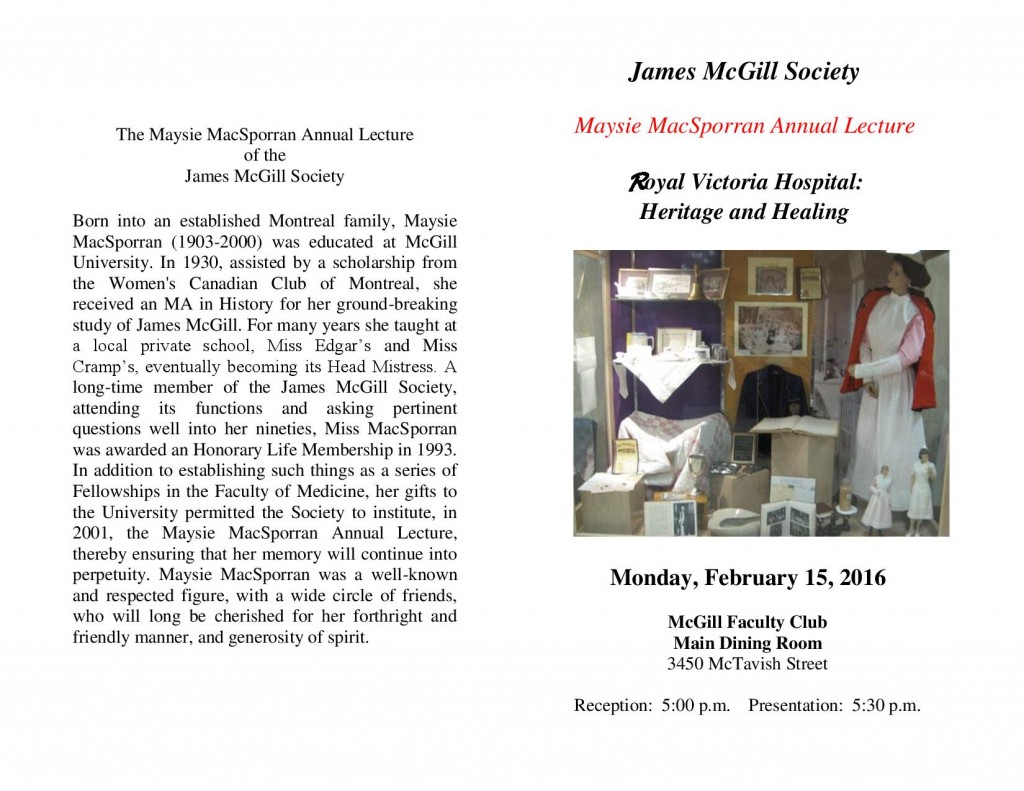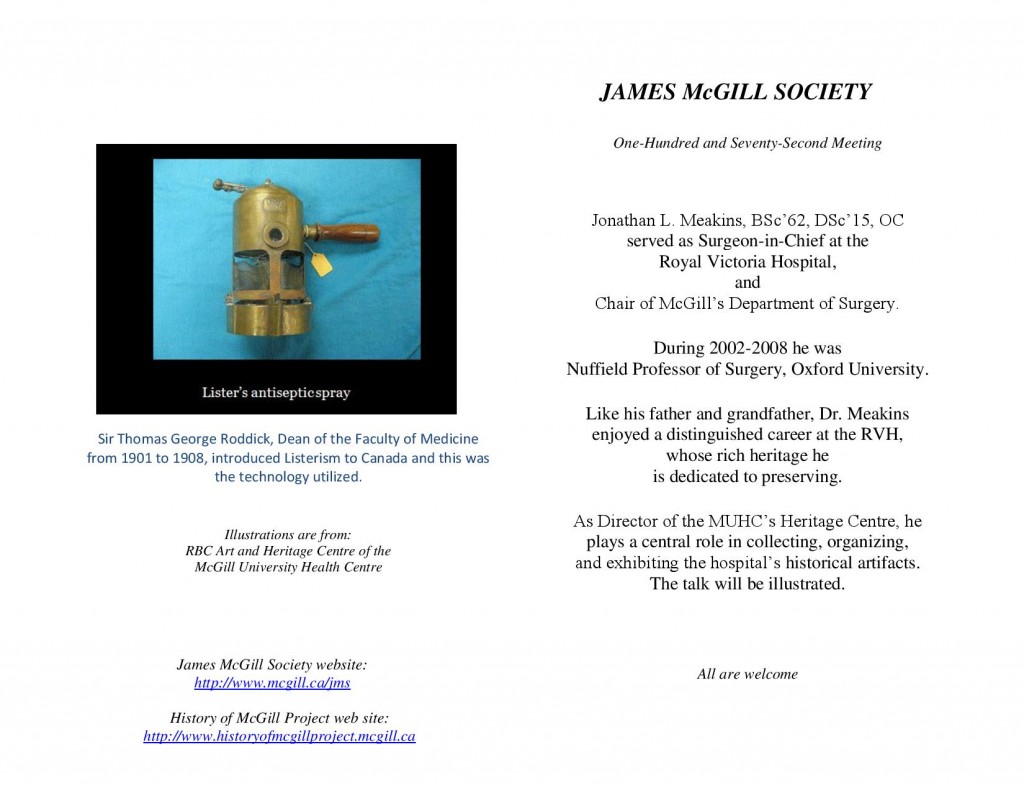La version française suit
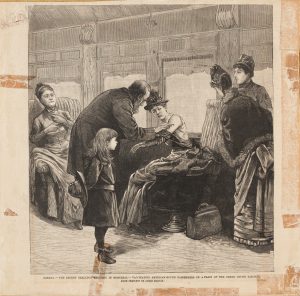
“The recent smallpox epidemic in Montreal – vaccinating American-bound passengers on a train of the Grand Trunk Railway,” by Marvin James, photo-mechanical reproduction of a wood engraving (1885). Osler Library Prints Collection, OPF000001.
Montreal 375 gives us the opportunity to reflect on the parcours of our city, to explore its past, and to bring this history into dialogue with our present. Our current exhibit at the Osler Library not only highlights the richness of our collections, but also brings them into contemporary conversations in a very Oslerian way. Sir William Osler collected his monumental library of the history of medicine not simply for the intellectual content or the beauty of the books and objects, but because he believed that we live with the past everyday: “the past,” Osler writes in his famous speech, Aequanimitas, “is always with us; never to be escaped; it alone is enduring.”
 Our newest exhibition, “Vaccination: Fame, Fear and Controversy, 1798-1998,” engages with local examples of historical vaccine controversies in an attempt to understand the enduring fear and hesitancy surrounding vaccination. Curators Dr. Rob Boddice of the Freie Universitat Berlin and Cynthia Tang, PhD candidate in the Department of Social Studies of Medicine/Department of History and Classical Studies, showcase the arguments made by pro- and anti-vaccinationists during the 200 years following Edward Jenner’s invention of vaccination.
Our newest exhibition, “Vaccination: Fame, Fear and Controversy, 1798-1998,” engages with local examples of historical vaccine controversies in an attempt to understand the enduring fear and hesitancy surrounding vaccination. Curators Dr. Rob Boddice of the Freie Universitat Berlin and Cynthia Tang, PhD candidate in the Department of Social Studies of Medicine/Department of History and Classical Studies, showcase the arguments made by pro- and anti-vaccinationists during the 200 years following Edward Jenner’s invention of vaccination.
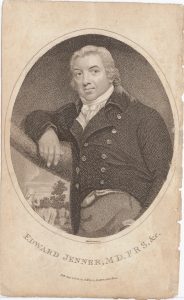
Stipple engraving of Edward Jenner by Mackenzie (London: T. Hurst, 1802). Osler Library Prints Collection, OP000643.
In 1798, Jenner, an English country physician, published the results of his experimental use of matter from cowpox pustules to inoculate patients against smallpox, which has long been endemic to industrialized cities like Montreal. This procedure, which Jenner named vaccination, was swiftly implemented as a standard public health measure and vials of vaccine were shipped and carried worldwide. However, vaccination’s benefits and promises were attended by controversy from its earliest days. Already at the beginning of the 19th century, popular pamphlets and images stoked public anxieties about the introduction of animal material and disease agents into the body. Even after the World Health Organization proclaimed smallpox eradicated in 1980, the debates surrounding vaccination that began in the 19th century have persisted in our public discourse.
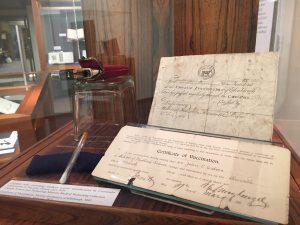
Glass capillary tube containing smallpox vaccine (Toronto, ca. 1939). Canada Science and Technology Museum, Medical Technology, art. no. 2002.0101.
A public panel presentation connected to the exhibition invited McGill and Montreal community members to think about how we understand such past examples of vaccine hesitancy and connect them to modern concerns and mythologies around vaccination. The two co-curators were joined by scholars Professor Andrea Kitta (East Carolina University), a folklorist specializing in medicine, belief and the supernatural, with a particular focus on vaccination, and late Dr. Mark Wainberg (McGill University), director of the McGill University AIDS Centre at the Montreal Jewish General Hospital, and outspoken critic of anti-vaccination rhetoric. The evening’s panel providing a wide-ranging and multidisciplinary perspective. More evidence as to the cross-institutional partnerships developed for this exhibition and the event is the blog post, “Hope and Fear in a Glass Capillary: Connecting over the History of Medicine with the Osler Library,” written by curator Cynthia Tang for the Canada Science and Technology Museum blog. In it, she explores a single artifact: a glass capillary tube containing smallpox vaccine manufactured Toronto circa 1939, and all of the hopes and fears contained within.
We are pleased to announce that this exhibition’s run has been extended through the summer! All are welcome to come view the exhibition during library opening hours (Monday through Friday, 9:00-5:00) in the Osler Library, 3rd floor, McIntyre Medical Building, 3655 Promenade Sir-William-Osler.

Montréal et l’histoire des débats sur la vaccination à la bibliothèque Osler

« L’épidémie récente de variole à Montréal — la vaccination des passagers américains dans un train du Grand Trunk Railway », par Marvin James, reproduction photomécanique d’une gravure sur bois (1885). Collection d’images de la bibliothèque Osler, OPF000001.
Le 375e anniversaire de Montréal nous donne l’occasion de nous replonger dans le parcours de notre ville, d’explorer son passé et d’en discuter dans le contexte actuel. En plus de mettre en évidence la richesse de nos collections, la nouvelle exposition présentée à la bibliothèque Osler permet d’engager des conversations les concernant à la manière d’Osler lui-même. Sir William Osler a construit cette riche bibliothèque sur l’histoire de la médecine, non seulement pour l’héritage intellectuel ou la beauté des livres et des objets qui s’y trouvent, mais aussi parce qu’il croyait que le passé fait partie de notre vie de tous les jours. « [traduction] Le passé, écrivait Osler dans son célèbre discours, Aequanimitas, fait toujours partie de nous et nous ne pouvons y échapper; c’est le seul qui résiste à l’épreuve du temps. »
 Notre nouvelle exposition, « Vaccination : Fame, Fear and Controversy, 1798-1998 », offre des exemples de controverses autour de la vaccination, qui faisaient rage dans la région à l’époque, en vue de permettre aux visiteurs de comprendre la peur et l’hésitation qui régnaient à son égard. Les conservateurs Rob Boddice de la Freie Universitat de Berlin et Cynthia Tang, candidate au doctorat au département des Sciences sociales en médecine et au département de l’Histoire et études classiques, présentent le raisonnement des personnes qui étaient en faveur de la vaccination et de celles qui s’y opposaient au cours des 200 ans qui ont suivi la découverte de la vaccination par Edward Jenner.
Notre nouvelle exposition, « Vaccination : Fame, Fear and Controversy, 1798-1998 », offre des exemples de controverses autour de la vaccination, qui faisaient rage dans la région à l’époque, en vue de permettre aux visiteurs de comprendre la peur et l’hésitation qui régnaient à son égard. Les conservateurs Rob Boddice de la Freie Universitat de Berlin et Cynthia Tang, candidate au doctorat au département des Sciences sociales en médecine et au département de l’Histoire et études classiques, présentent le raisonnement des personnes qui étaient en faveur de la vaccination et de celles qui s’y opposaient au cours des 200 ans qui ont suivi la découverte de la vaccination par Edward Jenner.

Portrait d’Edward Jenner par gravure au pointillé réalisé par Mackenzie (Londres : T. Hurst, 1802). Collection d’images de la bibliothèque Osler, OP000643.
En 1798, Jenner, un médecin d’Angleterre qui pratiquait en région rurale, a publié les résultats de ses expériences sur l’utilisation de matières extraites de pustules contenant le virus de la vaccine pour inoculer les patients contre la variole, qui a longtemps été endémique dans les villes industrialisées comme Montréal. Cette méthode, que Jenner a nommée vaccination, a été rapidement adoptée et généralisée comme mesure de santé publique, et des fioles de vaccin antivariolique ont été expédiées et distribuées dans le monde entier. Toutefois, les avantages et les résultats prometteurs de la vaccination ont dès le début fait l’objet d’une controverse. Déjà, au début du 19e siècle, la publication de brochures et d’images suscitait dans la population des inquiétudes liées à l’introduction de matière animale et d’agents pathogènes dans le corps. Même après l’annonce de l’Organisation mondiale de la santé en 1980, selon laquelle la variole avait été éradiquée, les débats publics amorcés au 19e siècle autour de la vaccination se sont poursuivis.

Tube capillaire contenant le vaccin antivariolique (Toronto, vers 1939). Technologie médicale, Musée des sciences et de la technologie du Canada, nº d’artefact : 2002.0101.
Dans le cadre de l’exposition, une présentation publique a été dirigée par un groupe d’experts à laquelle ont été conviés les membres de la collectivité de McGill et de Montréal. Cette initiative a porté les participants à réfléchir sur ces exemples passés de l’hésitation autour de la vaccination et à faire le lien avec les préoccupations et mythes sur la vaccination qui perdurent encore aujourd’hui. Les deux conservateurs étaient accompagnés des chercheurs Andrea Kitta (East Carolina University), une folkloriste spécialiste de la médecine, des croyances et du surnaturel, qui s’intéresse particulièrement à la vaccination, et feu Mark Wainberg (Université McGill), directeur du Centre universitaire sur le SIDA de l’Université McGill à l’Hôpital général juif de Montréal et critique de la rhétorique anti-vaccin. La présentation tenue en soirée a permis de dégager une perspective générale et multidisciplinaire. Le billet de blogue « Hope and Fear in a Glass Capillary: Connecting over the History of Medicine with the Osler Library » ([traduction] Espoir et peur dans une fiole de verre — Retracer l’histoire de la vaccination en compagnie de la Bibliothèque Osler), publié par la conservatrice Cynthia Tang pour le Musée des sciences et de la technologie du Canada, témoigne des partenariats interorganisationnels établis pour l’exposition et l’événement. Son bloque porte sur un seul objet : une fiole de verre contenant le vaccin contre la variole fabriqué à Toronto vers 1939, et tous les espoirs et les peurs qu’elle suscitait.
Nous sommes heureux d’annoncer que cette exposition se poursuivra durant l’été! Vous êtes tous invités à venir voir l’exposition durant les heures d’ouverture (du lundi au vendredi de 9 h à 17 h) à la bibliothèque Osler, 3e étage de l’édifice McIntyre Medical Sciences, 3655, promenade Sir-William-Osler.

 The Osler Library has installed a new mini-exhibition highlighting some items that shed life on past McGill Med student life. Textbooks, exams, photographs, and artefacts provide an important pictorial record of student life at McGill’s medical faculty and its teaching hospitals.
The Osler Library has installed a new mini-exhibition highlighting some items that shed life on past McGill Med student life. Textbooks, exams, photographs, and artefacts provide an important pictorial record of student life at McGill’s medical faculty and its teaching hospitals.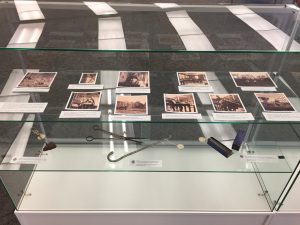 Ten photographs from the Isadore Hirshberg Fonds document the early career of an American medical student at McGill. Isadore Benjamin Hirshberg (1890-1965) was born in Bay City, Michigan, and began his medical studies at McGill in 1909 and graduated in 1914. In 1913 he trained at the Alexandra Hospital for Infectious Diseases when John McCrae was on staff and in 1914 interned at the Montreal General Hospital. During the First World War he served at the Canadian Explosives plant at Beloeil, Quebec, and was later among the founders of the Jewish General Hospital.
Ten photographs from the Isadore Hirshberg Fonds document the early career of an American medical student at McGill. Isadore Benjamin Hirshberg (1890-1965) was born in Bay City, Michigan, and began his medical studies at McGill in 1909 and graduated in 1914. In 1913 he trained at the Alexandra Hospital for Infectious Diseases when John McCrae was on staff and in 1914 interned at the Montreal General Hospital. During the First World War he served at the Canadian Explosives plant at Beloeil, Quebec, and was later among the founders of the Jewish General Hospital. Two examinations from 1865-66 show what 19th-century med students were expected to know. One question on the exam for “Theory and Practice of Medicine” asks, “Give the causes of Croup and of Laryngismus Stridulus, the means of distinguishing them from each other, and the treatment suitable to them.”
Two examinations from 1865-66 show what 19th-century med students were expected to know. One question on the exam for “Theory and Practice of Medicine” asks, “Give the causes of Croup and of Laryngismus Stridulus, the means of distinguishing them from each other, and the treatment suitable to them.”







